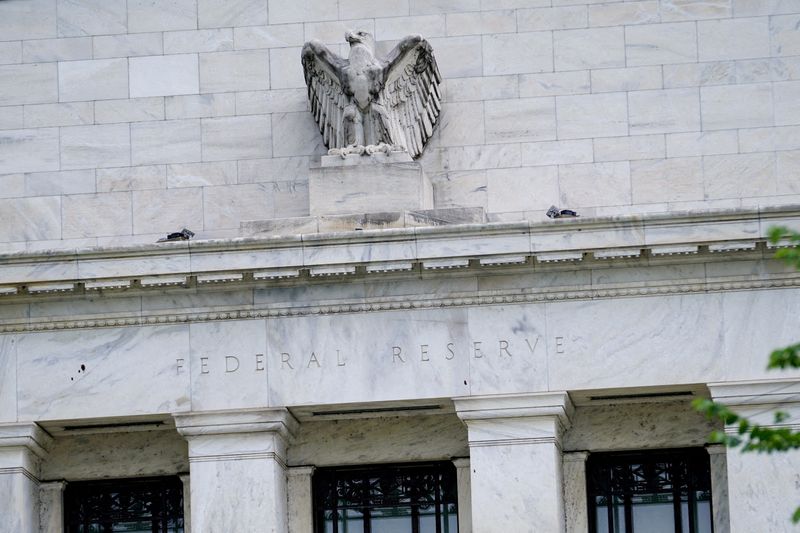By Davide Barbuscia
NEW YORK (Reuters) – The Federal Reserve’s aggressive start of the easing cycle has rekindled inflation worries in the U.S. bond market, as some investors fear looser financial conditions could re-ignite price pressures.
Yields on longer-dated Treasuries that are most sensitive to the inflation outlook have risen to the highest since early September, with some investors worried that the Fed’s shift in focus from beating back inflation to protecting the job market could allow for a rebound in price pressures.
“I think there are questions around how quickly inflation will be able to get to the Fed’s target if we’re in a cutting environment, and if we’re in an environment where the Fed is saying we want to support the labor market before the labor market gets weak,” said Cayla Seder, macro multi-asset strategist at State Street (NYSE:STT) Global Markets. She expects long-term yields, which rise when prices fall, to climb further as the market bets on stronger growth and inflation.
Fed Chair Jerome Powell said last week the 50 basis point interest rate cut that kick-started the U.S. central bank’s descent was a “recalibration” of rates aimed at maintaining strength in the labor market while inflation moves sustainably to the Fed’s 2% goal.
The Fed’s emphasis on economic resilience fueled concerns that the path to lower rates could be slow and bumpy. Fed officials’ forecasts on interest rates also suggested a more gradual pace in cuts than what the market anticipated.
Expectations for inflation over the next decade as measured by Treasury Inflation-Protected Securities (TIPS) increased after the Fed’s announcement on Wednesday, with the 10-year breakeven inflation rate rising to 2.16% on Thursday, its highest since early August. It hit a new high of 2.167% on Monday.
An auction of 10-year TIPS on Thursday, after the Fed’s rate-setting meeting, was lapped up by investors, with non-dealers absorbing 93.4% of the $17 billion Treasury debt sale, the highest share since January. Flows into U.S. dollar inflation-linked bonds, however, were negative in the week ending on Monday, according to LSEG data.
“Investors are once again concerned with the specter of reflation,” BMO Capital Markets rates strategists said in a note last week. Matt Smith, fund manager at Ruffer, said he has been adding inflation protection to his portfolio over the last few days and weeks.
Many in the market have fresh memories of the selloff that happened when a dovish pivot by the Fed in December was followed by months of upside surprises on inflation and employment.
The Goldman Sachs U.S. financial conditions index, a measure of the availability of credit in the economy, eased over the course of this year despite interest rates remaining at their highest in over two decades. The day after the Fed’s decision, it decreased to its lowest since May 2022.
“We think inflation is going to remain relatively benign … but the more aggressive the Fed cuts, the more you have to question that,” said Brendan Murphy, head of fixed income, North America, at Insight Investment.
FED PUT
Inflation, as measured by the U.S. Consumer Price Index, has dropped sharply over the past two years. It stood at 2.5% in August, down from an over 40-year peak of 9.1% in June 2022.
Fed Governor Christopher Waller said last week recent data convinced him the Fed needed to cut rates faster because it risked undershooting its 2% inflation target.
With the same information at hand, however, Fed Governor Michelle Bowman said she worried the larger move could be interpreted as “a premature declaration of victory” against inflation. She dissented over the U.S. central bank’s half-percentage-point interest rate cut last week and favored a quarter-percentage-point reduction instead.
Should inflation continue to subside the outlook for bonds would likely remain positive, despite the volatility that comes with a repricing of the pace of interest rate cuts.
But some wonder whether the central bank’s aggressive cut was premature, as inflation remains above target and recent monthly data indicated some stickiness in price pressures.
Referring to the so-called “Fed put” – a perceived tendency of the central bank to run to the aid of financial markets – economists at BofA Securities said in a note last week the “Powell put” came too early, given economic resilience and the stock market at record highs.
“A more aggressive easing cycle could make reaching the 2% target harder,” they said.

